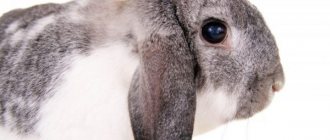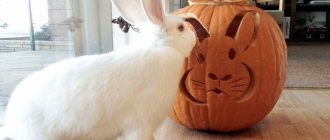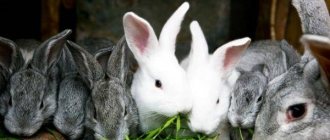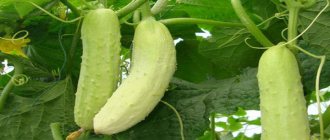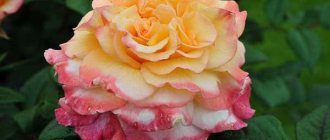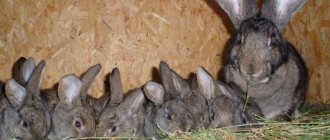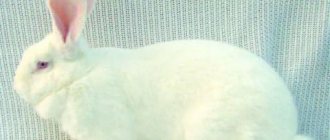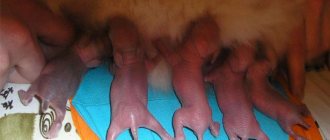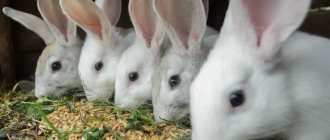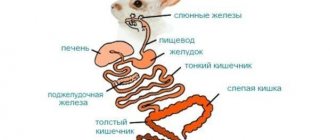Daily norm
The daily intake of a nursing rabbit should provide nutrients for herself and all her offspring.
The health and growth rate of the new generation of rabbits is greatly influenced by providing the lactating female with a complete daily diet. Therefore, its preparation should be taken seriously, and the amount of feed given should not be reduced throughout the entire lactation period:
- fresh meadow grass or good hay – 300 g;
- sunflower cake – 40 – 60 g;
- sunflower meal – 30 g;
- yeast biomass for animals – 5 g;
- fish oil (replenishes the supply of vitamins A and E) – 4 g;
- salt – 2.5 g;
- meat and bone meal – 7 g;
- bone meal and chalk - 3 g each.
The last two points are very important, since at the age of up to 2 weeks the baby rabbit has a weak skeleton. For its final formation, the animal’s body needs proteins and minerals, which the lactating female must transfer to the baby in sufficient quantities.
Semi-compacted litters
The female is mated 2-3 weeks after birth. Then the young animals are transferred to independent feeding on the 35th day after birth. With a warm rabbitry and sufficient food, matings take place all year round.
It has been noticed that rabbits from autumn litters get sick more often and grow worse, while the strongest ones are born in winter.
A female used for intensive breeding of livestock must be closely monitored. Before being brought together with the manufacturer, she is examined to ensure that there is no mastitis or discharge from the genitals. If after 3-4 litters the female rabbit becomes lethargic, reluctant to mate, or false mating occurs, this indicates that she needs rest. Perhaps after a 1-2 month break everything will return to normal.
Before mating, check the animal for mastitis, accompanied by inflammation of the nipple
For intensive breeding of herds, one-time female rabbits born at the beginning of winter are used. They are placed in separate cages and fed intensively. A single rabbit can be born at 4-5 months. By the end of the year she gives birth to 2-3 litters. Females are allowed to eat meat after the autumn moult if they have shown poor maternal qualities.
Composition of a nursing rabbit's diet
The amount of food is determined by the age of the cubs:
- in the first ten days of life, mother rabbits require 330 units of feed;
- from 11 to 20 days – 440 units;
- 20 – 30 days 560 feed units.
100 units require 16-18 grams of protein. To produce 1 ml of milk, 0.9 grams of protein will be needed.
Seasonal feeding habits
In summer, fresh green herbs, fruits and vegetables, and young grain shoots will become a rich source of vitamins. The basis of the rabbit's summer nutrition is:
In winter, when green grass is not available, the basis of nutrition is hay, preferably legumes, rich in protein. It’s good if the mixed hay contains vitamin herbs:
In winter, cake and bran help maintain health. They are high in fiber and protein. Be sure to include mineral supplements, special complexes or ordinary chalk in your diet.
Pet chalk
At any time of the year, a nursing rabbit should be given concentrates and mash.
Concentrated feeds and mash
Concentrated feeds allow you to increase the amount of nutrients and calories your animal receives. In a nursing rabbit, their share in the diet gradually increases due to hay and grass, and reaches 80% of the total diet. The following mixtures are used as concentrates:
Concentrated feed and compound feed are digested almost completely, up to 90%. You can purchase special feed and concentrates, the composition of which has a beneficial effect on lactation.
The mashes are formed from crushed feed. Suitable for nursing rabbits:
- 60% fine alfalfa and 40% crushed oats;
- 60% alfalfa and 30% barley, 10% corn;
- 60% alfalfa, 10% bran, 10% legumes; 10% wheat, 10% vegetables.
Special mineral complexes and a little sour or powdered milk are added to the mash. It is well accepted during lactation, enriches the diet with protein and calcium, and helps normalize digestion.
Use warm and moist mash. To do this, the grain is soaked in water, it becomes softer and brings more moisture into the body. Warm, moist mash has a particularly good effect on lactation in winter, combining food and warm drink.
If the female rabbit does not eat after giving birth or refuses water, stress factors may play a role. It should be placed in a quiet place and the rabbits should be applied to the nipples. Mating with a male also helps. After it, the hormonal levels will normalize, the animal will calm down and the condition will return to normal.
Properly organized nutrition and care during bearing and feeding offspring will allow you to get a healthy and active offspring and maintain the health of the female
Considering that a female rabbit can bring more than one offspring, it is important to preserve the resources of her body
Rabbits that do not belong to dwarf breeds enter the period of maturity at 5 months, they have a desire to continue their breed. If you suspect a female rabbit is pregnant, you should be sure of this (she may become falsely pregnant) and begin to change the animal’s diet, because the diet of pregnant and lactating females must be special in order to meet the needs of both mother and babies.
Diet during the postpartum period
In order for the animal to keep in good shape and easily withstand the period of feeding small cubs, you need to know what to feed the female rabbit after giving birth. The diet of a new mother is the key to the health of her babies.
Experienced farmers say that it is necessary to feed the female rabbit after birth with more nutritious food. Because her body must regenerate and still gain strength to feed her offspring. The time of birth most often falls at night or early morning. Duration about 25 minutes. After giving birth, the rabbit must be given clean water to drink. Milk begins to arrive immediately after birth. For good lactation, the female needs to be given herbs, such as:
- alfalfa;
- vegetable tops;
- clover;
- spurge;
- vegetables.
The rabbits' menu should include fortified mash of various additives, dried grass, oats and bran. Almost the same thing is added to the food as during gestation. After giving birth, the rabbit must also be fed generously. When the rabbits are 2.5 weeks old, they begin to eat a little adult food, so powdered milk is added to the mother's food. The average daily diet of a female weighing 5 kg in the postpartum period:
- first day – 330 g of feed;
- up to 20 days – 440 g;
- up to 30 days – 560g;
- before weaning baby rabbits from mother's milk - 700g.
What to feed a fledged female?
The body of a female who has given birth constantly needs nutrients. After all, she spent a lot of energy on the birth and gestation. And continues to spend them in the process of feeding the cubs.
So, a rabbit’s diet should include:
- bran/oats (nutrition basis changes every week);
- crude protein;
- mineral supplements;
- greens and corn;
- in winter - dry stems and leaves of legumes, boiled potatoes,
- in summer - nutritious greens (clover, alfalfa).
If the owner opts for concentrated feed, it should contain bran, oats and peas. A nursing mother is given about 200 grams in addition to the main food. hay, 50 gr. cake and meat and bone meal as a source of calcium.
House for a mother rabbit and her babies
The approximate amount of food for a nursing mother depends on the age of the rabbits. It is presented in the table below.
Table 1. Approximate daily amount of food for a nursing rabbit
| Age of cubs | Food volume |
| 1-10 days after birth | 320 g |
| 11-20 day | 440 g |
| End of 3rd week – 1 month | 570 |
| 1 month and beyond | 720 |
How many babies can a mother rabbit feed?
If the litter is not the first, and the mother constantly feeds the cubs, she can simultaneously provide food for 8 rabbits. With increased milk content, the figure can increase to 11, with decreased milk production it can drop to 6.
The feeding process is characterized by the following factors:
- An ordinary female has 8 nipples, so the same number of babies can suckle at the same time.
- If there are more than 8 cubs, the most agile ones will feed fully. It’s good if the mother produces a lot of milk, then after the first eight the remaining rabbits will eat.
- Stronger individuals in the fight for the mother's breast can trample weak brothers.
And the rabbit herself is capable of accidentally crushing them. Therefore, the farmer needs to remove them from the nest in time and move them to a nursing rabbit with fewer offspring. Mother rabbit feeding her babies
How often do babies eat?
After birth, each baby rabbit begins to eat 5 ml of milk per day. The owner must ensure that the kids eat at least 2-3 times daily. Ideally, they should be applied to the mother's breast 5 times a day. In this situation, each baby eats 1 ml of milk in one go.
Typically, a nursing female produces from 50 to 170 grams. nutritious milk depending on the number of rabbits. The first 2 decades of lactation account for 61% of all milk that appears during the entire feeding period. Therefore, at this time, babies should eat as intensely as possible.
Well-fed rabbits immediately fall asleep
How can you tell if baby rabbits are eating?
Usually the female feeds the babies in the dark or when no one is looking, so it is extremely difficult to notice the feeding process itself. The caring owner begins to worry about whether all the rabbits are getting enough to eat.
You can check if the kids are full as follows:
Inspect the tummies. Under the thin pink skin, you can easily see the belly and even see the crowns. In well-fed babies, the skin on the stomach is taut and there are no folds. Hungry people have sunken bellies and wrinkled skin. Weigh baby rabbits periodically. If babies do not gain weight for several days in a row, they clearly do not have enough milk
At the beginning of life, rabbits should regularly gain weight. Pay attention to behavior. Well-fed rabbits fall asleep immediately after eating, sleep soundly, do not twitch their paws or jump up.
Hungry animals look exhausted and lethargic, and constantly squeak. See where the cubs are lying. The babies, who are constantly lying outside the nest, in most cases tried to find their mother. They never found her and remained hungry. Weighing a rabbit
If the offspring is clearly larger than what the female rabbit can feed, several cubs are transferred to another female. They must be cleaned of their mother's down in advance and rubbed with down from the new nest so that they acquire the smell of a second home. This is the only way the new mother will accept them.
Little rabbit
What should feeding be like during low lactation?
Under normal home conditions, a female rabbit produces 180-200 g of breast milk per day. However, in some cases, the amount of milk produced by the rabbit sharply decreases, and the rabbits have to starve. This can happen for various reasons - stress, the age of the rabbit, or lack of nutrition.
In most cases, the amount of milk depends on the quality and quantity of food. Therefore, in order for newly born rabbits to eat well and plentifully, the newborn female must be switched to an enhanced feeding regimen.
We must remember that some types of herbs increase lactation, these are parsley, dill and elecampane. Therefore, to increase milk, you need to give the rabbit this particular herb. We also need to increase the consumption of wheat and corn.
If everything is in order, both nutrition and daily routine and living conditions, but the rabbit still has no milk, you need to take care of the rabbits yourself. You need to place them with different females for feeding or artificially feed them. Females with excess milk are quite common, and in order for them to accept a “foundling”, you just need to put him in her nest for a few hours. Having been saturated with her smell, someone else's rabbit becomes as dear to her as her own children.
Vitamins
Nursing rabbits need a higher content of vitamins.
You can purchase various vitamin preparations at your veterinary pharmacy.
"Chiktonik."
Contains a number of vitamins, including group B. The preparation also contains amino acids. Increases immunity. The solution is ready for use.
"Prodevit."
It is an excellent prophylactic for the prevention of vitamin deficiency. Contains vitamins A and E. It is an oily liquid. Improves metabolism and vision in the body of nursing females.
"E-Selenium."
Eliminates deficiency of vitamin E and selenium. Also contains retinol and vitamin D3. Normalizes metabolism and improves immunity. The solution should be added to drinking water in a ratio of one milliliter per liter of water.
Fish oil can also be added to food for nursing rabbits. The lack of vitamins can be replenished with injections or added to food and drinking water.
You can read more complete information here: https://petnaobed.ru/kroliki/chem-kormit-krolchixu-posle-okrola/
Mash
In autumn and winter, mash helps to compensate for the deficiency of many vital substances in the rabbit’s body. It is desirable that the diet of a nursing rabbit should contain up to 60% of oats or a mixture based on it, and up to 40% of alfalfa; Mineral supplements will also come in handy.
The mash may include:
- up to 10% flour made from alfalfa;
- up to 10% legumes;
- about 12% bran;
- mineral supplements.
The number of servings directly depends on the mother’s fatness and the number of rabbits. It is clear that the more babies suck milk, the sooner the rabbit’s body must make up for its deficiency. By 2-2.5 weeks, the rabbits learn from their mother to eat from the feeder, so the amount of food needs to be increased 3 times. You can add a little sour or powdered milk to the mash - this will only improve its nutritional value.
Diet of a pregnant rabbit before giving birth
The health of rabbits and mothers is established already in the pregnancy period. During this period, the diet must contain at least 220 feed units and it must be enriched with products with a high protein content at the rate of 10-15 g. protein per 100 feed units. The main part of the nutrients is spent on the growth of the young. Adequate nutrition will lead to proper formation and gestation.
It is best to use protein as a supplement; it is more fully and easily absorbed by the animal’s body.
Not only the volume, but also the composition of the diet changes. Vitamin and mineral components are added to enhance the protein component. In the second half of pregnancy, the content of large-volume feeds is sharply reduced, since the placenta puts pressure on the stomach and reduces its capacity. Concentrated feeds are better. With a smaller volume, they contain more nutrients.
Protein rich:
They should make up at least 25% of the total diet. Protein nutrition includes sunflower cake, soybean meal, 20-30 grams per day.
An important element of nutrition is vegetables. Boiled potatoes or raw chopped carrots, 100-150 grams each. In winter, a pregnant female can be fed with hay, in summer - with fresh green grass, 100 - 150 grams per day.
An important role is played by nutrition, which is necessary for the formation of the skeleton and nervous system of rabbits. This could be bone meal or crushed eggshells. From them, animals receive calcium and other minerals and essential microelements. The animal is given access to salt (2 grams per day) and given a small amount of fish oil, 1-2 grams of chalk.
If pregnancy occurs in winter, it is necessary to use special vitamin supplements; in warmer times, the need for vitamins is met:
- green types of feed;
- fruits;
- vegetables.
A rich source of vitamins are sprouted seeds.
Increased nutrition should not lead to obesity, otherwise the rabbits will be born weak. A week before giving birth, reduce the amount of bulk feed, introduce alfalfa and pea tops into the diet.
The presence of water in the drinking bowl before, during and after birth is the most important part of care. Increased thirst or lack of minerals and trace elements lead to aggressive behavior of the female rabbit; she can eat her cubs.
How do rabbits give birth in summer and winter?
In summer, the birth of a female rabbit is more difficult . Animals do not tolerate heat well, so births take place at night. Even mating of animals is recommended in cooler hours.
Before giving birth, you should check the nest in the queen cell. Excess fluff must be removed so that babies do not crawl around in search of coolness. During this period, the female needs more greens to produce milk.
The strongest babies are born in cold weather. The breeding process is simpler. Rabbits grow resistant to low temperatures. In cold weather, the female has low sexual activity, and she is completely absorbed in feeding the offspring. For winter breeding, a large recurrent female and a strong male are optimal.
Of the babies born, it is advised to leave the number of working nipples the rabbit has. This measure increases the chances of adequate feeding of the offspring. You need to make sure that there is always hay, combined food and fresh water in the cage.
Usually the female eats the afterbirth, this is a natural behavior. The placenta is rich in hormones necessary for lactation and restoration of the female reproductive system.
Childbirth in cages
Usually the female eats the afterbirth, this is a natural behavior.
Cage keeping of rabbits is the most common.
When constructing a cage, you need to consider the following points:
- cage dimensions (length – 1.80 m, width – 1 m, height – 0.65 m);
- height from ground to floor (about 50 cm);
- temperature regime (not lower than +6 °C);
- illumination (at least 16-17 hours a day).
Before childbirth, the mobility of the uterus decreases. If 28-33 days have passed since the date of mating, we can talk about the beginning of labor. To avoid loss of offspring (a rabbit may eat her babies when stressed), the cage must be covered with dense material.
Be sure to read:
What can you feed rabbits to gain weight quickly in summer and winter, and what not?
In solitude, the animal will calmly give birth, lick, feed and cover the babies with fluff.
Fostering in burrows and pits
In nature, animals live and breed in burrows. Children raised this way are the strongest. But in this case it is impossible to control the mating of pets and the birth of rabbits.
Rabbit breeders sometimes use conditions for keeping animals that are closest to natural ones and build artificial burrows. The outdoor cage is connected by a manhole to a hole inside a warm barn. This way the nest is warm, and fresh air and light come from the side of the cage.
Birth of baby rabbits
Childbirth begins with weak contractions, then the attacks intensify and turn into attempts, and labor begins. Since the female has a two-horned uterus, the babies come out of each horn in turn, or first one cavity is emptied, then the second.
The process may take about half an hour.
Labor is considered complete when the uterus:
- chews the umbilical cord;
- eats the placenta;
- licks the cubs and arranges them in the nest (covers them with down).
Important! During the birth process, a female rabbit loses a lot of energy and experiences extreme thirst. Lack of water in the cage can cause the newborns to be eaten.
Diet of a pregnant rabbit
In general, a healthy pregnant female should consume an amount of food per day equivalent to 220 grams of feed units, of which 30-32 grams should be digestible, complete protein - it is most easily absorbed by the animal's body.
Rabbit
During this period, the animal’s body consumes a large amount of nutritional compounds to build the placenta, skeleton and other organs of the developing embryos (the weight of each in the first half of pregnancy is about three grams). An even greater increase in the feeding standards of the expectant mother occurs in the second part of pregnancy, the future rabbits in the uterus reach their maximum weight, the placenta grows, and the rabbit’s mammary glands swell.
We invite you to familiarize yourself with: Wild rabbit is... What is Wild rabbit?
During this period, the correct selection of the volume and diet of her feeding is reflected in the successful outcome of pregnancy and the weight of the cubs at birth (and therefore their viability). You should also reduce the volume of food in favor of calorie content and a higher content of nutrients, since the volume of the stomach in pregnant females decreases - the ever-increasing uterus puts pressure on it.
The list of what can be given to pregnant rabbits daily includes:
- various combined feeds, legumes, oat grains per 80 grams (spring and summer) and 100 grams (winter);
- pressed sunflower cake – 30-50 grams;
- soybean meal – from 20 to 30 grams;
- various vegetables and fruits: boiled potatoes, raw chopped carrots - from 100 to 150 grams;
- in winter: hay – 120 grams, in summer: green juicy grass (alfalfa, pea tops, meadow grasses) – 0.5-0.7 kg;
- sprouted grains of wheat or oats, as an important source of vitamins;
- bone flour, chalk, ground eggshells as “building material” – 1-2 g;
- table salt – up to 2 g;
- fish fat – 2 gr.
Additional Information. If pregnancy occurs in a young, still growing female, her diet should be 1/5 more, since she also requires nutrients and vitamin complexes for her own development.
What to feed and what to give a pregnant rabbit, starting from the second half of pregnancy? Concentrates should be about 45 percent, alfalfa (in the form of hay or grass) 43 percent, meadow hay 10 percent, mineral admixtures 2 percent. Additionally, you can give high-quality hay and green twigs - such roughage contains a lot of raw fiber, which helps the functioning of the pregnant intestines.
It is necessary to ensure that increasing the diet does not contribute to obesity in the female, which will have a detrimental effect on the future offspring.
A few days before delivery, it is necessary to reduce the volume of food by about a third, while leaving the amount of water the same.
The approximate daily diet for a female who has given birth is as follows:
- grass or bean hay – 100-300 grams (or a kilogram of grass);
- sunflower cake – 40-60 grams;
- seed meal or bran – 30 grams;
- combined feeds – up to 80 grams;
- bone or meat flour – 3-7 grams;
- fish oil and chalk - approximately 3-4 grams each;
- salt – about 3 g;
- yeast for feed – 5-6 g.
At three to four weeks, each healthy baby rabbit will try to eat from its mother’s bowl, so it is also necessary to replenish it with crushed grains of wheat and oats (previously steamed in water for 3 days and cooled). For young rabbits, after giving birth, young grated carrots and their tops are added.
Rabbits
Mixers are of the following types:
- chopped alfalfa 0.6 units; crushed oats 0.4 units;
- alfalfa 0.6 units 0.3 units barley 0.1 units corn grains;
- alfalfa 0.6 units 0.1 unit bran 0.1 unit legumes 0.1 unit wheat grains 0.1 unit chopped vegetables.
It is useful to add some mineral complexes and any fermented milk product to the finished mixture. Such food helps to improve the digestion of the offspring and replenishes the protein-calcium deficiency in the body of the mother rabbit.
How to check if a rabbit has milk
Based on some signs, it can be understood that the rabbits are not receiving enough nutrition. They are restless, move erratically, and do not gain weight
In such a situation, it is important to check whether the rabbit has milk
A nursing rabbit requires special attention from the owner
To find out you need:
- Lay her on her back.
- Examine the condition of the nipples. Swollen mammary glands indicate milk production.
- Lightly press on the nipple. If milk comes out, then everything is fine.
Note! The sufficiency of lactation can only be judged by the well-being of the rabbits. If they are calm and their tummies are full, then you can calm down
How many rabbits can a mother rabbit feed?
How many rabbits a female rabbit can feed depends on the number of nipples and the production of a large volume of milk. The female rabbit has 4 pairs of nipples. It is desirable that the number of cubs be no more than 7-8 pcs. In this sense, Flanders are ideal. They usually give birth to 6-8 rabbits. All offspring receive an individual nipple, and they have a greater chance of surviving to adulthood.
If the rabbits are larger, the strongest ones attach to the nipples first. The remaining weaker ones eat after them. This is the best case scenario.
Often this process is regulated by the rabbit herself, that is, she simply eats the weak ones immediately after giving birth.
The rabbit breeder has two more options:
- place extra rabbits with another nursing long-eared mother;
- organize artificial feeding.
Note! You can also try to increase the lactation of a nursing female. Juicy foods, nuts, and dill help increase milk volume
Boiled potatoes give good results.
How many times a day do baby rabbits suck their mother's milk?
It is difficult to notice how many times a mother rabbit feeds her young rabbits per day. Nature dictates that the female is close to her offspring only when no one is around. This animal behavior is determined by genetics. For wild relatives, this is because the mother's scent can attract hunters. Babies do not have a strong smell. They will be safer away from their mother.
Force feeding baby rabbits
Since the mother rabbit feeds the babies 1-2 times a day and only in the dark, the behavior of the nursing rabbit can cause concern, especially for novice rabbit breeders. To dispel doubts, you should check her milk supply. If the reason is that the female simply does not want to accept cubs, you will have to look for alternative feeding options. This could be another lactating female, artificial feeding. You can force a female to feed her children.
How many days do baby rabbits suckle their mother?
Domestic rabbits are kept for meat or fluff. In any case, the priority is to obtain a large number of livestock. In this regard, the feeding period of the rabbits depends entirely on the owner. But you need to understand that mother’s milk is the baby’s immunity for life.
Often young animals are removed at the age of one month. In any case, the baby rabbits should already be able to eat adult food.
The optimal period for breastfeeding is 1.5 months of age. It is customary to keep large breeds near their mother for two months. Sometimes even this period is not enough. For example, the survival of the offspring depends on how much a female rabbit rabbit feeds her young. Early weaning from the mother can lead to the death of most babies.
Important! A break in feeding of 4 days or more stops lactation irrevocably
How to determine the satiety of offspring
The owner almost never manages to catch the mother nursing, so there is always a fear that the babies are not fed. The satiety of newborns can be understood by their appearance. Fed babies delight with plump bellies. This is especially noticeable on a naked body. On stretched, thin skin, blood vessels even become visible.
Well-fed rabbits are well-fed
Important! If the cubs crawl out of the nest and have folds on their tummies, then they do not have enough milk. Urgent measures need to be taken
Malnutrition is especially dangerous in the first week after birth.
Rabbit food groups
A mammal from the hare family should under no circumstances starve. Insufficient or improper feeding can not only cause a slowdown in growth processes and diseases, but can also provoke the death of the animal.
There are four main groups of rabbit food, which make it easy to provide the animal with complete and balanced nutrition: roughage, green food, concentrates and succulent food. Green food is used mainly in the spring and summer, and can be represented by:
- wild herbs;
- sown cereals, legumes and leguminous crops;
- vegetable tops, including the aerial parts of Jerusalem artichoke, turnips, rutabaga, sugar and fodder beets;
- feed cabbage.
It is best to set aside areas where clover, alfalfa, lupine, vetch, oats, winter rye, barley and corn are sown independently. Cereals, legumes and legume-cereals contain a significant amount of protein, as well as vitamins and minerals.
However, as rabbit breeding practice shows, green feed should be given in mixtures, which will reduce the risk of flatulence in the rabbit.
It is important to remember that tomato tops are strictly contraindicated for rabbits, while potato tops can be used, but with great caution. It should also be taken into account that beet tops have a laxative effect, so their amount in the total green mass should be minimal
Equally important for proper digestion are roughage, which should make up a quarter of the diet. This category includes hay and tree branches that need to be harvested in spring and summer, as well as grass meal. The grass is cut for hay before flowering and dried first under the sun and then under a ventilated canopy. Rough feed should be stored in dry rooms, on special wooden floors. Branch food:
- linden branches;
- maple branches;
- willow branches;
- willow branches;
- acacia branches;
- poplar branches;
- rowan branches;
- aspen branches;
- ash branches;
- elm branches;
- oak branches;
- lilac branches;
- apple tree branches;
- raspberry branches;
- pear branches;
- hazel.
In small quantities it is allowed to feed branches of birch, plum, cherry and sweet cherry. Branches from plants such as bird cherry, elderberry, wolf's bast, apricot, buckthorn and wild rosemary are strictly unsuitable. In winter, the diet is supplemented with fresh branches of coniferous trees.
Particular attention should be paid to succulent feed, represented by root vegetables and silage, including watermelons, pumpkin, cabbage, potatoes, carrots, cuuzica, beets and zucchini. Any succulent food is very well eaten by rabbits and is almost completely digested
A very complete and highly nutritious silage is represented by a mixture based on beets, carrots and cabbage, with the addition of tops.
Concentrated feeds, represented by cereals, legume grains, cuts, meal, cake, mixed feed and feed of animal origin, have the greatest nutritional value. Such mixtures have a high energy value due to the large volume of proteins and a minimal amount of water. Valuable crops include oats, corn, barley, wheat, sorghum and rye, as well as peas, lentils, beans and soybeans. Oats are given whole, crushed or rolled. Wheat, sorghum, rye and barley are pre-crushed and mixed with other foods. The amount of wheat should be limited.
What to do if there is not enough milk
Rabbits' milk is very fatty (about 15%). Even three meals a day allows children to grow and develop well. If baby rabbits constantly squeak, run randomly around the nest, and have a thin belly with folded skin, then they do not have enough nutrition.
To increase the rabbit's lactation, you need to add dill, elecampane, rowan berries, dandelion, clover, nettle or sedge to the mash, and increase the amount of vegetables and fruits in the diet. Oxytocin is sometimes used as an injection.
Babies may go hungry because the mother is stressed, even though she has enough milk. Then you need to provide the female with normal living conditions. If nervousness is caused by sexual heat, then mating is necessary.
Types of food for rabbits
The selection of diet is based on the age, weight and health of the animal. These factors allow you to determine your daily nutrient intake and required amount of fiber.
There are 4 main types of food:
- coarse (straw, hay, branches of coniferous and deciduous trees, shrubs);
- green (plantain, rhubarb, dandelions, wild herbs);
- concentrates (cake, bran, legume grains, corn, barley);
- juicy (beets, carrots, turnips, pumpkin, cabbage).
Feeding methods are also divided into:
- dry - use ready-made feed containing all the required vitamins and minerals;
- mixed – liquid mixtures that include all types of feed.
Roughage
Rough food consists of hay, bark and tree branches. They harvest it in the summer and feed it all year round. These foods do not contain water and are rich in fiber. They saturate, provide the animal’s body with vitamins, improve digestion, and have a positive effect on weight gain. In addition, they help sharpen the incisors.
Preference is given to meadow hay; it contains many vitamins, protein and minerals. It is mowed before flowering, dried in the sun, then transferred to a pre-prepared, well-ventilated place, protected from the sun. Branch food is also added to the rabbits' menu. To prepare it, young shoots with leaves are plucked from trees.
The following trees and shrubs are suitable for feeding:
- willow;
- maple;
- Linden;
- lilac;
- poplar;
- aspen;
- Rowan;
- oak;
- ash;
- Apple tree;
- pear;
- hawthorn;
- pine;
- spruce;
- raspberries;
- blackberry.
Branches of wild rosemary, bird cherry, elderberry, plum, apricot, cherry, black cherry, wolf's bast and buckthorn are excluded due to the content of hydrocyanic acid.
Green feed
Main food from spring to autumn. Rich in fiber and protein. Meadow or wild grass is used. For good digestion, wormwood and dill are added to the menu.
It is not recommended to eat green tomatoes and potatoes, wild plants (celandine, buttercups, lilies of the valley, cherry). They contain toxic substances that can lead to poisoning and, subsequently, death. In practice, it is recommended to reduce the amount of beet tops, give cabbage leaves gradually, and give the rest of the green food in mixtures; there is a risk that the rabbits will develop flatulence.
Concentrates
The main diet of animals is concentrated feed, approximately 65-70%. These include feed and grains. The latter should be ground and moistened if they belong to legumes and cereals. Grains of different varieties are mixed for better absorption.
The feed contains minerals and vitamins. They provide the most nutritional value for rabbits. Are divided into:
- complete - do not require the addition of other types of food;
- feed additives - contain protein, vitamin and mineral complex, serve as a supplement to the main type of nutrition;
- concentrate feed - mixed with roughage or succulent feed.
For adults and newborns up to 1 month, PC 90-1 is suitable, for rabbits aged 2-4 months - PC 93-1. A portion of this food for a mature animal is 120 g, for young animals - 50 g.
Juicy feed
In winter, the amount of this type of food in the diet is increased. They give preference to those that contain a lot of liquid (root vegetables, melons). Juicy food improves digestion and also contains less fiber and a higher percentage of carbohydrates. This is especially suitable for the diet of lactating females and for the fertility of males.
In winter, animals are often given carrots, rich in vitamin A, or potatoes, which contain starch that is beneficial for the digestive system.
You can diversify the menu with fodder beets or beet tops. It starts metabolism and strengthens the immune system
It is introduced into the diet carefully, as flatulence is also possible
The table shows the methods of serving succulent food and its benefits:
| Product | Preparation | Benefit |
| Potato | Raw or boiled. Mix with mixed feed, grain crops (millet, oats, corn, barley). | Affects weight gain. |
| Beet | Fresh, steamed. | Increases immunity, enhances metabolism, cleanses the blood. Give in small portions (50 grams for an adult rabbit). |
| Pumpkin | Boiled, unprocessed. In the form of puree. | Promotes weight gain, improves wool quality, strengthens the immune system, and increases the amount of milk in a nursing rabbit. |
| Cabbage | Fresh, pickled. | Contains vitamins C, E. Affects the coat. They are given in small quantities. |
| Carrot | Raw, in pieces or whole. | Supplies the body with B vitamins and vitamin C. |
| Zucchini | Boiled, fresh. | Improves digestion. Give in summer and autumn. |
Fruits are given in small quantities to avoid bloating. Preference is given to apples, pears, and in rare cases, melon and watermelon rinds.
Newborn examination
After giving birth, the long-eared one gets out of the nest to eat and drink, then her access back to the queen cell is blocked and the babies are examined. The inspection is carried out extremely carefully, trying not to leave any odor; before doing this, you should thoroughly wash your hands with water without soap. Rabbits can be touched, but very carefully.
Why an inspection is necessary:
- Remove stillborn rabbits.
- Count the harvest.
- At the first birth, a large litter is divided, removing several young rabbits, which are nursed independently or given to another mother who has recently given birth with fewer babies.
Appearance of babies
Small rabbits can look unusual, being completely hairless, blind, deaf and tiny in size. Their body is thin, wrinkled, red or pink, the ears are small, the head is not proportional to the body, and there are white, rather sharp claws. Despite the lack of hair, newborns already have 16 baby teeth. During this period, they especially need care, because rabbits are absolutely helpless.
If the rabbit has given birth for the first time, it is worth monitoring how she behaves, whether she feeds the babies and how she takes care of them.
Development of baby rabbits by day
On the first day, the babies are completely bald, they don’t see or hear anything. But by nature they are given a fairly high speed of development, so already on the third day they acquire downy “plumage”, which thickens every day. The weight of newborns is approximately 40−70 g; if the uterus has a lot of milk, then the weight gains quickly. Like all babies, during the first days the cubs eat their mother's milk and sleep a lot, huddled together. The rabbit constantly licks the babies, at the same time calming and caring for them.
On the second day, the baby's weight becomes twice as much as it was at birth. The main responsibility for the health of the cubs during this period lies with the mother; the breeder is only required to maintain a comfortable air temperature and the correct diet for the rabbit. For insulation, you can use a heater that is installed near the cage or enclosure.
On days 5-7, noticeable guard hairs appear, the presence of which increases, and by 20-25 days they turn into a full-fledged fur coat. By one month, the babies should be completely covered with fur.
On the tenth day, rabbits begin to open their eyes and their weight increases 9 times. The eyes begin to open gradually from the inner corner.
When babies leave the nest
Usually, baby rabbits leave the nest at 15-18 days. Already at two weeks of age, babies begin to crawl out of the queen cell, run around the area next to their mother and try to eat plant foods. The strongest and bravest pets are the first to leave the home and try to quickly explore the territory and get acquainted with the outside world.
There are cases when babies leave the nest prematurely. This occurs due to high temperature in the queen cell or lack of food. In addition, the baby rabbit may accidentally fall out. Whatever the baby is, it must be returned to the queen cell.
At the age of 1 month, the fur is fully formed, and its length reaches 2-3 cm. At the same age, the first molt begins, clearing the fur of the original fluff.
If the babies don't have enough milk
If young animals leave the queen cell early, this indicates a lack of food. To do this, children are weighed to determine the level of hunger and developmental delays. If the uterus cannot cope with the responsibilities of a mother and is unable to feed the babies on its own, they are separated or fed from a special syringe with a nipple. Feed with milk mixtures, diluting them according to the instructions. As a feeding apparatus, you can use a pipette, a syringe or a thick piece of cotton wool moistened with milk.
What to feed baby rabbits after leaving their mother
During the first 14 days after the birth of the rabbits, it is important to balance the rabbit’s diet as much as possible so that her milk is nutritious and contains all the necessary elements for the growth and development of the younger generation. If for some reason the female refuses to feed her cubs or they do not receive the required amount of energy from food, complementary feeding should be introduced in the form of special feed and hay
In the case of early transplantation of young animals, it is necessary to follow the feeding recommendations outlined below.
At 1 week
From the age of one week, rabbits can be given adult food little by little. At first it should only be special feed, hay, meat and bone meal and fish meal. Gradually you can introduce grains. For better absorption of food, you should give sour milk and herbaceous plants (chamomile, St. John's wort, yarrow).
Week-old eared animals are fed 5 times a day (2 times at night). So that the fragile organisms of the rabbits do not experience severe stress, add 50 ml of vitamin B to the drinking water.
Read more about whether it is possible to give quinoa grass, grain and corn to rabbits.
At 2 weeks
At this age, the nutrition of small eared animals is not much different from what it was before. The diet remains the same, but the number of meals is reduced (night feedings are removed), and the volume of food consumed increases. 2-week-old babies are given twice as much food as 1-week-old babies.
At 3 weeks
At 20 days, the baby rabbits' teeth change, so they can now eat rougher food. You can add dry herbal mixtures (twice a week), more grains, herbal granules, bran to your existing diet.
At 1 month
At this age, babies are already able to eat adult food. Milk is gradually being replaced from their diet. In its place come mash, feed, hay, and grass. Vegetables are gradually introduced, starting with potatoes, then carrots. It is better not to give cabbage, as it can cause bloating.
At 2 months and older
From 2 months of age, the diet of young animals becomes similar to the menu of an adult animal.
Important! Regardless of the age of the baby rabbit, there should always be a container with clean fresh water in its cage, and the feeder should always contain food that does not spoil quickly. The feeding scheme for a baby rabbit aged 40 days and older may look like this:
The feeding scheme for a baby rabbit aged 40 days and older may look like this:
| 1 kg live weight | 100 g feed units |
| Dry matter (62 g) | Digestible Protein (16–17 g) |
| Feed units (70 g) | Calcium (0.6 g) |
| Metabolic energy (730 kJ) | Phosphorus (0.3g) |
| Carotene (1 mg) | |
| Vitamin D (3 mcg) | |
| Vitamin E (2.8 mg) |
In summer it is advisable to feed the baby rabbits:
- young grass;
- fishmeal;
- mixed feed;
- powdered milk;
- oats;
- carrots;
- boiled potatoes;
- bran (a little);
- chalk, salt;
- vitamin-mineral complex.
How much per day to feed a female rabbit after giving birth?
It is not easy to calculate the amount of food that should be enough for a nursing rabbit during the day because of the variety of diets that are used in the household. How often to feed a suckling female, each owner must independently calculate the needs of constantly chewing mothers. Meanwhile, a standard for daily requirements for basic feed has been developed:
- Concentrate - up to 0.1 kg, in summer and up to 0.13 kg, in winter;
- Juicy - within 0.3 kg, in any season of the year, to cover milk production;
- Grass ad libitum, add twig food;
- In winter, hay is given ad libitum at the rate of 0.2-0.5 kg per female.
- Drinking water is constantly in the drinking bowls; in winter it can be replaced with warm wet food;
- Be sure to take vitamin and mineral supplements (according to instructions)
The amount of protein for a pregnant and lactating female is important; its requirement is approximately up to 20 grams in pure form per day
Rest period
The period of relative rest in males and females is not the same. In adult males it occurs in the intervals between matings, in females - after the placement of the young animals of the last birth and before the start of preparation for the next mating
During this period, it is important to maintain normal fatness of rabbits, especially females.
During the rest period, rabbits are less demanding in terms of quantity and quality of food. All the nutrients they receive now are used to maintain life. That is why during this period you can feed less valuable feed: weeds, melon waste (in summer), hay, silage and rag feed. Concentrated feed is given in limited quantities. If rabbits have poor body condition at the time of rest, they should be given additional feed.
During this period, the following diet is sufficient for adult rabbits of large breeds:
• 50-60 g of mixed feed or cereal grains;
• 150 g of sugar beets or potatoes;
• 100 g of hay and 200-250 g of silage.
• 40-50 g of mixed feed or cereal grains.
When baby rabbits leave the nest
All rabbits begin to leave the nest at three weeks of age. Getting to know the “adult” world involves some nuances:
- From this moment, acquaintance begins not only with the external habitat, but also with “adult” food - the baby rabbits try food from their mother’s feeder, which should only contain products that are harmless to babies. Gradually, the eared animals will move from such complementary foods to the normal diet of adults.
- During this period, it is necessary to change the bedding in the cage so that the miniature rabbits do not get dust into their eyes. The best option is to temporarily lay down a clean, thick cloth or towel.
- Breeders conduct a control examination of the physiological development of the offspring. If it is discovered that the rabbits are not growing well, then the rabbit’s menu is immediately revised or the baby rabbit is transferred to a female with more high-calorie milk. If there is a weakened rabbit in the brood, it is better to remove it from the nest so that the female rabbit does not begin to notice the difference among the cubs and does not abandon the entire brood because of this.
- From the 28th day, rabbits begin to be vaccinated against diseases according to the approved vaccination schedule.
Video Inspection on the 3rd day after birth
Why do baby rabbits leave the nest early?
When a mother rabbit throws her cubs out of the nest or the baby rabbits begin to emerge before three weeks of age, there may be several reasons for this behavior:
Lack of milk in the female. A decrease in the amount of rabbit milk or a decrease in its nutritional properties indicates that the rabbit is not eating properly. To restore normal lactation, you should review the eared mother’s diet, make it more nutritious, and adjust the diet and volume of food. Taking good care of your rabbit is the key to getting healthy offspring from her. If lactation cannot be restored, then the offspring are placed with another lactating rabbit or artificially fed.
Increase in air temperature in the queen cell. In order for the baby rabbits to feel comfortable and cozy, the temperature in the nest should be controlled. When it becomes very hot and stuffy, the problem can be eliminated by moving the cage to a cooler room or to the open air under a canopy.
It is important to remember that the rabbits should not emerge from the queen cell before the due date. If this problem occurs, you should quickly find and eliminate the cause, otherwise you may lose the brood
When can weaning take place?
It is recommended that older rabbits be separated from their mother no earlier than 1.5 - 2 months of age, provided that they already eat full adult food, do without milk, and do not get sick. The weaning procedure is carried out gradually, removing 2 rabbits from the litter daily. In this way, the female will physiologically and painlessly stop lactation.
Typically, females are placed in cages of 3-4 individuals, and males are castrated or transferred to individual cages (provided they are kept for breeding).
After weaning, the most important aspect is the diet of the young animals. They should receive a high-calorie diet rich in proteins and carbohydrates. It is recommended to enrich the food composition with mineral and vitamin premixes. If 3-4-month-old young animals gain weight well and quickly, then the transition to adult food has taken place well, and the selected nutrition meets all the nutritional needs of actively growing organisms.
Video NEWBORN BABIES
The diet of a female rabbit during pregnancy
A healthy brood can only be produced by a healthy individual that has been provided with the necessary nutrients. The diet for a pregnant rabbit should be made taking into account the fact that not only the expectant mother needs more vitamins, macro and microelements, but also the embryos inside her.
Signs of pregnancy in "eared cats"
Six months for giant breeds and five months for large and medium-sized rabbits is considered an acceptable age for procreation. Gestation lasts an average of 30 days, it all depends on the number of rabbits.
Everyone understands that the animal will not tell you about its “interesting situation”, so you should be very observant to determine pregnancy. This must be especially monitored after deliberate mating. It may not be possible to do without consulting a veterinarian.
Female rabbits most often become shy and nervous after fertilization. They can even have miscarriages if you scare them too much. Also, the female will begin to fight off the male and hide in the corners of the cage if you try to bring them together.
By 12 days after mating, with a careful examination of the abdomen, embryos can already be felt; they are the size of a grape, and by 21 days, movements in the abdomen are observed.
Nutrition of a pregnant rabbit
After mating or pregnancy is determined, females are switched to more nutritious food. On average, food is given 220 grams more, while for every 100 grams of food, 15 is digestible protein. There should be a lot of clean and fresh water in the drinking bowl.
You also need to know what to feed the rabbit before giving birth if she is still young. The main nuance is that such organisms continue to develop themselves along with the young inside them. Therefore, the amount of their food increases by 20 percent compared to adults.
Also, if a new pregnancy and breastfeeding of the previous litter are combined, an average of 350 grams of food is added to the total amount of food and 18 grams of digestible protein is added for every 100 grams.
Sample menu for a rabbit before giving birth
Feeding during the second half of pregnancy looks something like this:
- 2% mineral supplements;
- 10% meadow grass;
- 43% hay;
- 45% grain feed.
Tree branches are also given, which improves food digestion processes.
It is important to know that overfeeding a pregnant rabbit is just as harmful as underfeeding it. Excess weight in an animal is dangerous because the offspring will not be viable
Calculation of a rabbit's milk production based on the results of grading
At the same time, the conditions of detention are more important than the breed and constitution of the rabbit. In bad conditions, the most elite female rabbit will stop feeding her babies
Methods for selecting dairy rabbits for breeding assessment:
- Examination of the mammary glands, the female rabbit normally has 8 nipples (4 on each side). Sometimes 10 nipples, usually vestigial. Visually normally developed, excretory ducts are visible.
- The girth of the chest behind the shoulder blades, the larger the volume of the chest, the more oxygen the female consumes and is able to produce a lot of milk. Females with the best chest measurements are selected;
- Body length, the longer the body length, the better the blood supply, the greater the likelihood of milk production. Females with the best measurement results are selected. Length from the point on the forehead, between the ears, to the root of the tail.
- Condition of the bones in the limbs. The more massive the bone, the greater the likelihood of selecting a good dairy female. Select the best based on measurement results.
- Condition of the skin. Assess the skin on the withers or croup. Evaluate by eye. Females with the thickest skin fold are selected.
An approximate menu option before the babies are born
Let's give an example of how to feed pregnant rabbits. If the above recommendations are applied from the first day of fertilization of the female, then this menu is effective only in the second half of pregnancy:
- 45% grain feed;
- 43% hay;
- 10% succulent herbs;
- 2% mineral supplements.
Please note that the total ration is 100%, but this designation is conditional. You can add tree branches to the menu of pregnant rabbits
They have a positive effect on the digestive process
Vegetables and fruits should not be completely excluded, but they should be given with caution so that babies do not develop an allergic reaction.
Remember that excess weight does not benefit the animal, so overfeeding rabbits is dangerous for their health. In the worst case, this will lead to the death of the offspring and disruptions in the functioning of the female’s body.
Caring for baby rabbits
The sooner the rabbits are left without a uterus, the more complex care they need. Living conditions and feeding regime require great responsibility and dedication from a person.
Lighting and heat
Newborn rabbits require special care; attention should be paid to lighting and warmth when raising babies.
There must be a place in the cage where the sun's rays do not reach. Direct solar radiation is dangerous for animals. Daytime lighting should be dim, and at night it is recommended to turn off the lights.
The rabbits should be warm. To do this, build a nest from the fluff of adult rabbits or place a heating pad in the cage. The optimal temperature is when a person's hand is comfortable, not hot.
Hygiene
Cleanliness when caring for rabbits is necessary, because without immunity they are more susceptible to germs and bacteria.
Boil dishes and teats before use. Prepare mixtures before feeding according to instructions. Store milk in the refrigerator for no more than 3 days.
Before feeding, wash your hands with fragrance-free soap and dry with a towel. After feeding, clean your babies of any leftover food and feces.
Abdominal massage
Emptying the bowel and bladder requires special attention, because babies do not know how to cope with it.
Before feeding, the female licks the baby rabbit, pressing on the belly with her tongue, moving from the navel to the hind legs. Thus, it forces the intestines and bladder to empty.
A person who replaces a mother for rabbits should not forget about this procedure. Otherwise your bladder will burst.
Before each feeding, it is necessary to massage the baby rabbit's abdomen with a damp soft rag or a piece of cotton wool.
This manipulation is completed when the offspring are more than 14 days old.
Healthy rabbits have a firm and slightly convex belly. If it is sunken, then this is a sign of gastrointestinal problems.
In the video below, the breeder clearly shows how to massage a rabbit’s belly before feeding:
Caring for orphaned rabbits requires a lot of strength, skills and patience. This is the only way they will survive and grow into beautiful, healthy individuals.
0
0
Copy link
